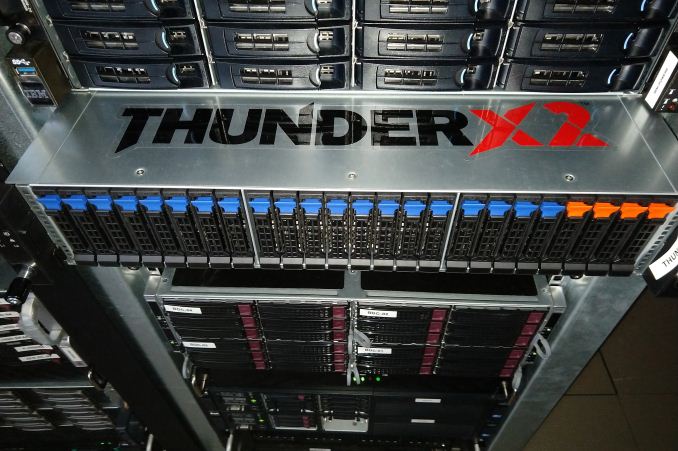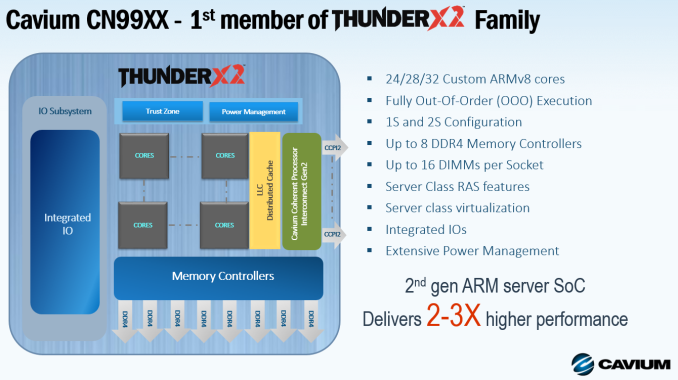Assessing Cavium's ThunderX2: The Arm Server Dream Realized At Last
by Johan De Gelas on May 23, 2018 9:00 AM EST- Posted in
- CPUs
- Arm
- Enterprise
- SoCs
- Enterprise CPUs
- ARMv8
- Cavium
- ThunderX
- ThunderX2

A little less than 2 years ago, we investigated the first Arm server SoC that had a chance to compete with midrange Xeon E5s: the Cavium ThunderX. The SoC showed promise, however the low single-threaded performance and some power management issues relegated the 48-core SoC to more niche markets such as CDN and Web caching. In the end, Cavium's first server SoC was not a real threat to Intel's Xeon.
But Cavium did not give up, and rightfully so: the server market is more attractive than ever. Intel's datacenter group is good for about 20 Billion USD (!) in revenue per year. And even better, profit margins are in 50% range. When you want to profits and cash flow, the server market far outpaces any other hardware market. So following the launch of the ThunderX, Cavium promised to bring out a second iteration: better power management, better single thread performance and even more cores (54).
The trick, of course, is actually getting to a point where you can take on the well-oiled machine that is Intel. Arm, Calxeda, Broadcom, AppliedMicro and many others have made many bold promises over the past 5 years that have never materialized, so there is a great deal of skepticism – and rightfully so – towards new Arm Server SoCs.
However, the new creation of underdog Cavium deserves the benefit of the doubt. Much has changed – much more than the name alone lets on – as Cavium has bought the "Vulcan" design from Avago. Vulcan is a rather ambitious CPU design which was originally designed by the Arm server SoC team of Broadcom, and as a result has a much different heritage than the original ThunderX. At the same time however, based on its experience from the ThunderX, Cavium was able to take what they've learned thus far and have introduced some microarchitectural improvements to the Vulcan design to improve its performance and power.
As a result, ThunderX2 is a much more "brainiac" core than the previous generation. While the ThunderX core had a very short pipeline and could hardly sustain 2 instructions per clock, the Vulcan core was designed to fetch 8 and execute up to 4 instructions per clock. It gets better: 4 simultaneous threads can be active (SMT4), ensuring that the wide back-end is busy most of the time. 32 of those cores at clockspeeds up to 2.5 GHz find a home in the new ThunderX2 SoC.
With up to 128 threads running and no less than eight DDR4 controllers, this CPU should be able to perform well in all server situations. In other words, while the ThunderX (1) was relegated to niche roles, the ThunderX2 is the first Arm server CPU that has a chance to break the server market open.











97 Comments
View All Comments
Davenreturns - Wednesday, May 23, 2018 - link
In the spec table for the AMD EPYC 7601 you have max sockets 4 and PCIe 3.0 lanes as 64. I thought the max sockets was 2 and that the total number of PCIe 3.0 lanes was 128 (64 in a dual socket machine).davegraham - Wednesday, May 23, 2018 - link
max sockets is 2 and PCIe lanes is 128 (64 from each 7601 for a combined total of 128; remember, each 7601 has 128 PCIe lanes by themselves. 64 from each are ganged together for IF in a 2P system).davegraham - Wednesday, May 23, 2018 - link
*are not *isDavenreturns - Wednesday, May 23, 2018 - link
But in a single socket motherboard system, the total PCIe lanes available from one EPYC processor is 128 which I think we are both saying is correct.Davenreturns - Wednesday, May 23, 2018 - link
The reason I think these two corrections are important and should be addressed by the author is the way the players in the market are competing. The table should read 128 PCIe lanes and 2 sockets max for EPYC. One only needs to look at AMD's EPYC One socket page to understand why it is important.https://www.amd.com/en/products/epyc-7000-series-1...
The page is filled with marketing trying to convince customers that you are actually getting a two socket server in just one socket. And yes 128 PCIe lanes are available to the customer in these one socket products as part of the reasoning.
The max number of sockets is also important. AMD and probably Cavium are both arguing that 90% of the market only needs 1 or 2 sockets. Intel doesn't agree and provides 4 or more socket configurations.
The one socket argument centers around the I/O and memory channels available in the AMD processor. Even though the table just might have typos, reviewers around the web had a hard time believing that a single chip offered 128 lanes of PCIe connectivity and I found a lot of misinformation. It continues today.
DanNeely - Wednesday, May 23, 2018 - link
AFAIK even for intel 1/2 socket machines are around 90% of their sales. They're just selling enough total server chips in total that catering to the sliver of the market that does want 4/8way configurations is still worth their time.Arnulf - Sunday, May 27, 2018 - link
Profit margins in that market segment are likely to be way higher so it's worth it for Intel as long as there is no competition, forcing prices downwards.Ryan Smith - Wednesday, May 23, 2018 - link
You are correct. Thanks for pointing that out.Davenreturns - Wednesday, May 23, 2018 - link
Thanks so much, Ryan.vanilla_gorilla - Wednesday, May 23, 2018 - link
"This is because the customers who have invested in expensive enterprise software (Oracle, SAP) are less sensitive to cost on the hardware side, so they are much less likely to change to a new hardware platform."I don't really follow the logic here. Just because you spend a lot more money on software doesn't mean you wouldn't try to save money on hardware. You don't only focus on one related expense because it's larger.